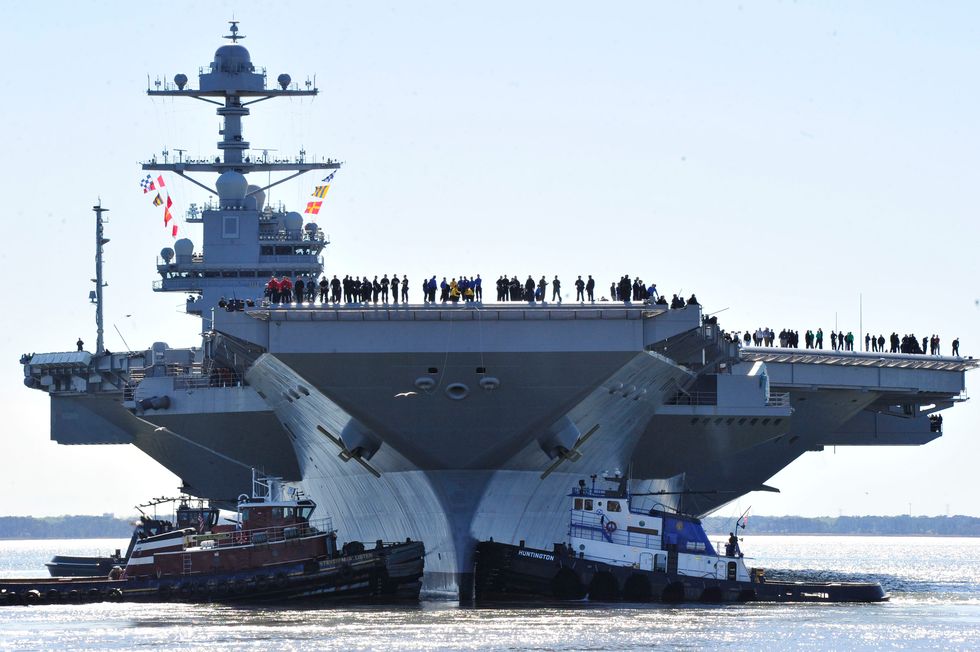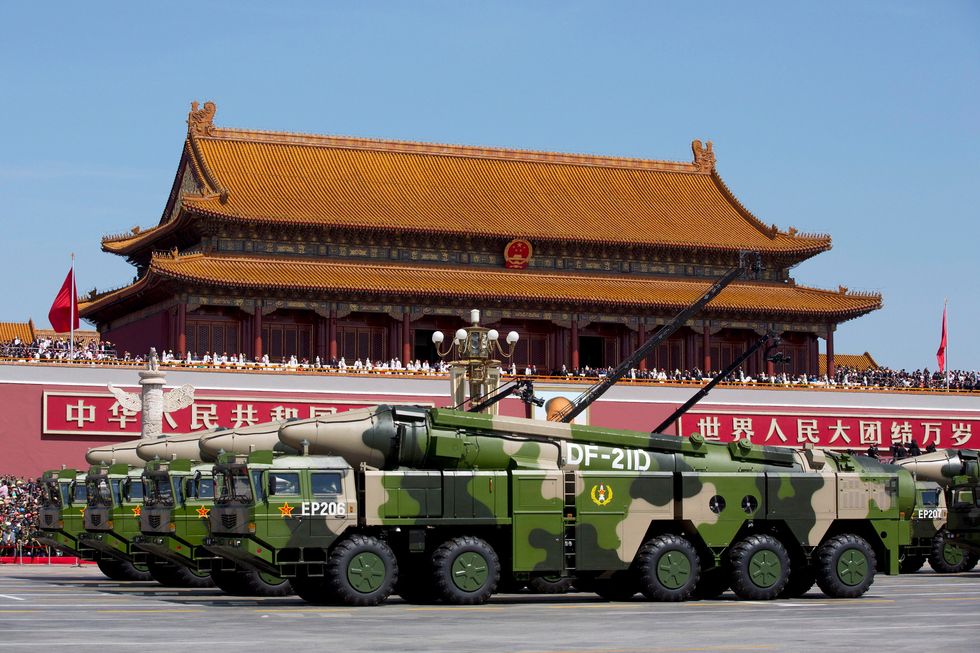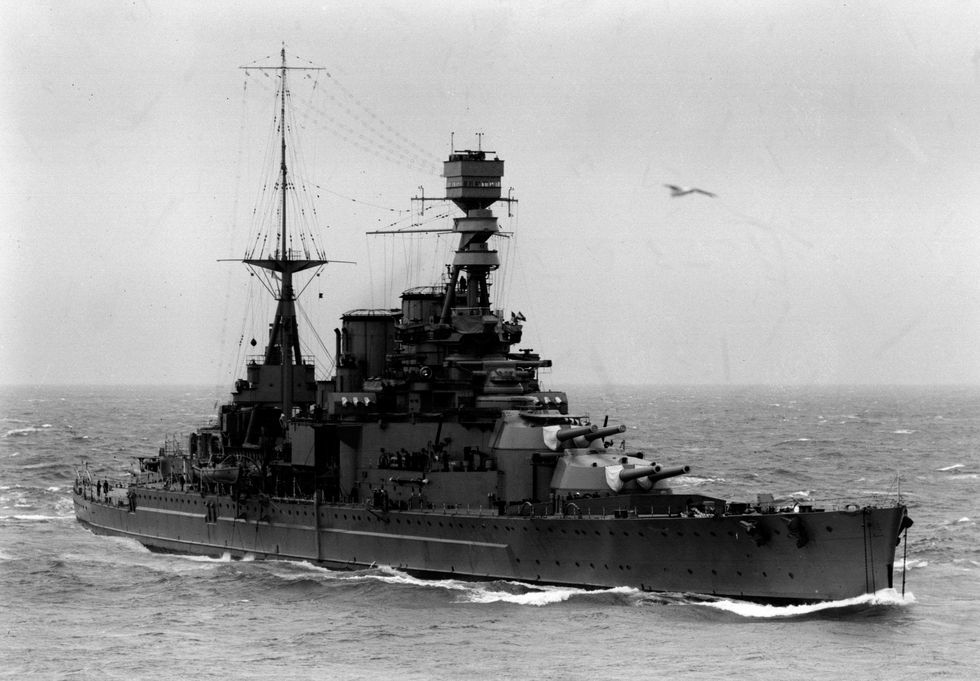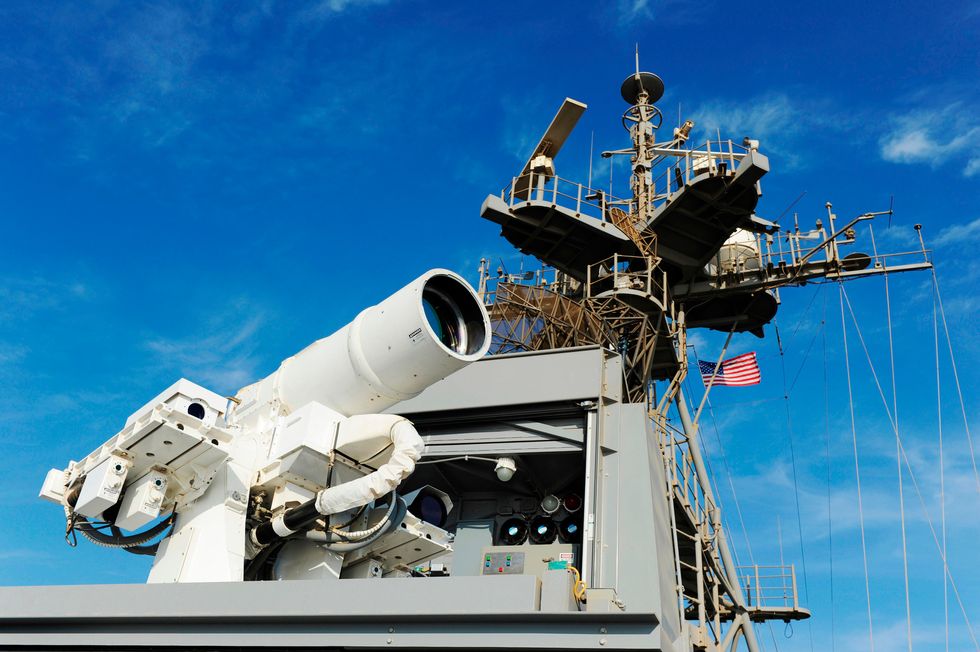Lasers Are the U.S. Navy’s New Superweapon

On October 4, America’s newest aircraft carrier, USS Gerald R. Ford, deployed for the first time amid rising tensions across the Pacific and uncertainty about the role these seafaring behemoths will play in the future of warfare.
The $13.3 billion Ford is the largest and most expensive warship ever to sail. It boasts a sprawling five-acre flight deck and new technologies aimed at making it (and carriers like it) the world’s most powerful well into 2050 and beyond. The vessel holds four squadrons of fighters on board and a bevy of support and tactical aircraft—more than 60 planes in all, though it can accommodate as many as 90. Its airpower exceeds that of at least 60 nations, and it houses more stealth fighters than are found in all of Russia’s armed forces.
Ford stands more than nine stories above the waterline and weighs 97,000 tons. That’s 32,000 tons heavier than the largest battleships of World War II. But big doesn’t mean slow. Powered by a pair of advanced A1B nuclear reactors, the ship has nearly three times the power of America’s existing supercarriers, about 300 megawatts of electrical power in all, according to the Navy. Seeing it on the water is like watching a New York City block cruise past at 34 miles per hour.
But new anti-ship missiles from China, some capable of maneuvering at hypersonic speeds above Mach 5, threaten to render Ford and the Navy’s entire Pacific Fleet obsolete. In the same way that an emerging technology in World War II—squadrons of attack planes—was deployed by Japan to sink the most powerful U.S. and British battleships, these new missiles have the potential to wipe out the most advanced ships currently sailing the oceans.
A sobering report from the Congressional Research Service, updated in August 2022, points to concerns “about the survivability of Navy surface ships in potential combat situations against adversaries, such as China, that are armed with large numbers of UAVs and anti-ship missiles, including advanced models.”
While Russia also possesses hypersonic weapons, China worries the Navy most. The country has aggressively scaled the size of its naval fleet in the past decade and has developed several anti-ship weapons—including highly maneuverable hypersonic missiles capable of reaching Mach 10. China isn’t hiding the fact that those weapons are intended to repel American ships; one of its weapons-testing sites tucked away in the Taklamakan Desert has full-size mock-ups of U.S. aircraft carriers that it uses for target practice.
China’s buildup comes at a precarious time for the region. The country claims sovereignty over nearly all of the South China Sea, extending thousands of miles from its own shores. Those territorial lines are heavily disputed; international law recognizes territorial claims only 12 nautical miles offshore. America’s allies in the region rely on our naval presence to maintain free shipping lanes, says Jason Lyons, a retired Marine and former CIA officer. That puts the Pacific Fleet within range of China’s anti-ship missiles and drones without the ability to reliably defend itself or mount a counterattack; neither of the fighters operated aboard U.S. flattops (the F/A-18 Super Hornet and F-35C Joint Strike Fighter) can reach targets farther than about 700 miles away. That’s not just a problem for the U.S. Navy. It’s an existential crisis.
Ford and ships like it have a battery of antimissile defenses, but none are capable of protecting it in a prolonged battle against China’s latest weapons. To maintain dominance in the Pacific—to just keep its ships afloat—the Navy is going all in on a new technology that has remained out of reach for decades: the laser. The benefits are tantalizing. Powered by a large fuel source—Ford’s hulking nuclear reactors fit the bill—lasers fire at the speed of light, negating the speed of hypersonic weapons; they can reload quickly to fend off swarms of drones; and they don’t require stores of ammunition, giving ships nearly unlimited firing opportunities.
That is the Navy’s hope, at least. Defense contractors have recently tested lower-powered lasers—one even shot down a drone earlier this year—but a reliable laser with enough power to stymie hypersonic missiles is years away. Nevertheless, the Pentagon has confidence in the emerging technology—so much so that this year, it canceled research into two other promising weapons, rail guns and special gun-launched guided projectiles (GLGPs), that it had hoped could defend its fleet against modern weapons. With those projects shelved, the question is: Can the Navy develop this technology quickly enough to thwart a threat before it’s too late?
In 2021, the Biden Administration formed a Pentagon task force to assess the threat posed by China’s rapid naval expansion. One year later, based on the task force’s findings, the Department of Defense declared China as America’s “most consequential strategic competitor.”
China now has a fleet of more than 770 naval, coast guard, and other military vessels. That’s more than twice the size of America’s fleet. And it’s concentrated almost entirely in the Pacific, whereas the U.S. fleet is dispersed between the Atlantic and Pacific regions. China’s strength is also bolstered by an arsenal of advanced anti-ship weapons, which it can launch from ground bases, warships, and aircraft. The most potent are its long-range missiles like the DF-21D, DF-26, and DF-ZF.
China’s missiles are capable of inflicting catastrophic damage. Its 35-foot-tall DF-21D is a ballistic nuclear missile that can destroy ships from 1,000 miles away or more. China can launch this 32,000-pound weapon from the ground or from heavy bombers in the air, and analysts believe that its nuclear warhead can maneuver in flight to hit moving ships.
The DF-26 stands more than four stories high and has an even greater range. But the most fearsome is the DF-ZF, a hypersonic missile that can reportedly reach speeds of Mach 10 and attack from more than 1,500 miles away. Unlike the other two weapons, which fly in a conventional arc that makes them more easily intercepted, the ZF remains highly maneuverable as it reenters the atmosphere and zooms toward a target.
Even shooting down a slow-moving missile challenges the Navy’s best defenses. “Intercepting missiles in flight is one of the most complicated fire-control problems that exists,” says retired Navy Master Chief Don Garcia, a weapons specialist who served on destroyers and cruisers. The DF-ZF’s speed and unpredictable path would make it almost impossible to stop with existing defenses.
China’s hypersonic weapons aren’t the only threats. Carrier commanders have long understood their vulnerability to batteries of anti-ship cruise missiles. When fired in high numbers, the weapons can overwhelm a ship’s defenses. Swarms of relatively cheap, long-range suicide drones could cripple a carrier group just as easily.
The Navy’s concerns about Chinese anti-ship weapons are borne from history. On December 10, 1941, just three days after the Japanese bombed Pearl Harbor, the British deployed a small but powerful fleet of warships toward the Malay Peninsula.
The fleet, called Force Z, included four destroyers and two massive battleships. HMS Repulse was a veteran of the First World War and received significant upgrades in the 1930s. The lead ship of the group, newer and more advanced, had already earned acclaim for its pivotal role in sinking Germany’s 50,000-ton battleship Bismarck seven months earlier.
The Royal Navy was aware of the impact that airpower could have on warfare at sea, but its leadership underestimated its destructive capacity. Admiral Thomas Phillips, the commander of Force Z, reportedly refused to coordinate with the Royal Air Force for cover. As Japanese bombers crested the horizon at 11:18 a.m., his error became apparent.
All four destroyers and both battleships opened fire with weapons ranging from 40-millimeter autocannons to three-inch anti-aircraft guns, zigzagging their courses to dodge the torpedoes that Japanese bombers lobbed into the sea. Within the first hour, Repulse captain William Tennant reported dodging 19 of them. The new battleship wasn’t so lucky. After taking a direct hit, Prince of Wales listed to port. Two more torpedoes soon tore through its hull, and then another found Repulse’s port side.
Like carriers today, battleships were considered the largest and most powerful vessels on the high seas. That fateful morning, Repulse became the first major warship in history to be sunk by aircraft. Just minutes later, Prince of Wales became the second. By 1:20 p.m., both ships had slipped beneath the waves.
Replace airplanes for drones and high-speed missiles, and the Navy’s predicament becomes clear. Its largest carriers and most heavily armed destroyers aren’t equipped to defend against throngs of invaders descending from the air.
Today, USS Gerald R. Ford sails with what’s called a carrier strike group—an armada of 10 or more cruisers, destroyers, and frigates, and sometimes a submarine or two. At least two of those vessels specialize in air defense, usually Arleigh Burke–class guided-missile destroyers. These ships provide the first layer of protection against enemy attacks using powerful onboard radars to detect targets more than 200 miles away. The ships are armed with surface-to-air missiles and the Navy’s Phalanx CIWS (Close-In Weapon System), which operates radar-controlled 20mm 6-barrel Gatling cannons that fire 4,500 rounds per minute. They’re almost identical to the massive cannons fired by American fighter jets, such as the F-16.
All told, a carrier strike group has enough hardware to intercept dozens of inbound missiles from as far away as 200 miles. But it becomes defenseless as soon as the ships run out of interceptors to fire, which must be stored and then restocked after the battle. Some munitions can be replenished at sea, while missiles must be resupplied back at port. The Pentagon calls this a “depth of magazine” problem, something enemies can exploit with swarming attacks.
The best defense against swarming drones, the Pentagon believes, are photons released by highly agitated atoms. Pump enough electricity through atoms—or ions, or molecules—to really excite them, and they will emit light. Then trap that light between mirrors so it bounces back and forth, exciting those tiny particles even more. Channel that amplified light into a narrow beam and blast it toward a target at the speed of light, and you have a laser.
Unlike blasters in Star Wars, laser beams don’t explode when they hit a target. Instead, they deliver intense heat. At lower power output, lasers can confuse the optical sensors on a drone. Increase the power and a laser will burn a hole through it.
Essentially, lasers turn energy into ammo. Powered by nuclear reactors like those on Ford, they can potentially fire thousands or even tens of thousands of times at incoming munitions. And because laser beams travel at the speed of light, lasers can track and target unpredictable weapons like China’s hypersonic DF-ZF better than conventional missiles—gunners won’t have to lead a target and anticipate its location the way they do currently.
The Pentagon likes their low cost, too. When planning for battles against an economic peer like China, defense analysts worry about economics in addition to firepower. The Congressional Research Service estimates that firing a high-powered laser will cost somewhere between $1 and $10—just a fraction of the $1 million to $10 million that defensive missiles cost. Using million-dollar missiles to fight off swarms of relatively cheap enemy drones or cruise missiles is what those analysts call a “negative cost-exchange ratio.” Cheap-to-fire lasers rebalance that equation.
For all their power and promise, lasers can appear rather pedestrian. In 2014, the Navy installed the first laser on a ship for sea trials. Fitted forward on the deck of the amphib transport ship USS Ponce, the 33-kilowatt AN/SEQ-3 Laser Weapon System (LaWS) had a short, round firing tube painted white. Two smaller tubes for sensors rest on the shoulders. To an untrained eye, it looked like an amateur astronomer’s telescope. But even this early low-power version delivered striking firepower.
In one test, the Navy deployed a small Zodiac inflatable speedboat with replica cannons mounted above a dummy driver. As the raft sped away, gunners used the LaWS’s sensors to aim the laser. Outside the ship, the video shows the LaWS rotating slowly as it tracks and locks in on the target. It fires silently and without warning—an invisible ray of extremely agitated atoms traveling at the speed of light. Instantly, the replica cannons atop the Zodiac explode, and shrapnel splashes into the ocean nearby. It’s a direct, accurate hit, with no visible damage to the boat or the driver. In another test, the LaWS successfully took out a drone launched from the deck of a nearby ship. As the laser engaged the drone, the intense heat cut into the aircraft like a blowtorch. Within seconds the drone had caught fire and plummeted toward the sea.
A second, stronger laser entered trials in 2019; then in August 2022, the Navy installed its first permanent laser on a destroyer, the Arleigh Burke–class Preble. Developed by Lockheed Martin, the weapon has a 60-kilowatt power output that integrates with the ship’s advanced AEGIS radar and weapons control system. The Navy calls it HELIOS, or High-Energy Laser with Integrated Optical Dazzler and Surveillance system. The Navy’s contract with the developer calls for at least one more of the $105 million lasers, with an option to purchase up to nine in all. Later versions could be even more powerful. Lockheed Martin says the weapon could eventually scale to 150 kilowatts, but even at that strength it will be most useful against drones and small surface ships.
To stop a barrage of cruise missiles or a hypersonic weapon barreling toward Ford at Mach 5 or faster, the Navy needs something much more powerful. To thwart cruise missiles, the Navy estimates that it needs at least a 300-kilowatt laser. In addition to the size and speed of those missiles, their nose cones are made out of such materials as pyrolytic graphite or Pyroceram ceramics designed to withstand the high heat inherent to supersonic flight, which can top 1,000 degrees Fahrenheit. Lasers will have to fire with enough intensity to rapidly burn through those heat-resistant substances. They also need enough power to overcome the effect of atmospheric turbulence on the laser. Finally, they require quick identification of the precise target point on an inbound missile traveling at 1 mile per second to take it out.
That weapon appears to be on the way. The Navy plans to begin testing a 300-kilowatt weapon as early as next year and calls the experimental weapon HELCAP, for High Energy Laser Counter ASCM Program. (ASCM stands for anti-ship cruise missile.) A 2020 photo taken of a wallboard behind Chief of Naval Operations Admiral Michael Gildan appears to show that the HELCAP test bed will be based on the Navy’s existing AN/SEQ-4 Optical Dazzler Interdictor (or ODIN) system, which is already being fielded on some destroyers. If successful, the platform will be the Navy’s first laser capable of shooting down incoming anti-ship cruise missiles.
Even HELCAP won’t be enough to stop hypersonic missiles flying at speeds up to Mach 10. Those weapons are manufactured to withstand temperatures of 1,700 degrees Fahrenheit or hotter. The Pentagon believes it may take a 1-megawatt laser, more than three times the power of HELCAP, to stop them. But megawatt-class lasers may not be too far off either. The Navy awarded a contract to Northrop Grumman to develop such a laser, and in July 2022, the company completed a preliminary design of a high-energy laser that combines several laser beams into one powerful ray. Northrop said it will initially develop a prototype with up to 300 kilowatts of power, but that the technology may allow it to scale up the power to 1 megawatt.
For the Pentagon, which has billions invested in aircraft carriers, that technology can’t arrive soon enough. Given the rapid emergence of China’s anti-ship weapons, warships like Ford are more vulnerable than they have been in 80 years. The fate of the world’s most powerful navy could be decided by a single, well-aimed hypersonic shot. To prevent its aircraft carriers from meeting the same fate as World War II battleships, it’s going all in on lasers—betting that it can develop the sci-fi tech into a powerful and reliable defense. No matter how fast or powerful anti-ship missiles become, the Navy hopes its futuristic lasers can burn them out of the sky for less than the cost of a cup of coffee.








/cloudfront-us-east-1.images.arcpublishing.com/gray/KOE2KJ2UTNBUFO5ZFB2BJHRTCM.JPG)




